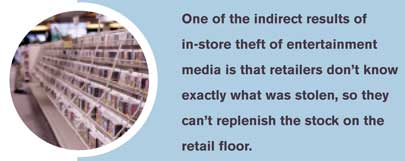Timing is everything when it comes to the release of a blockbuster movie to DVD. Nearly 80 percent of all sales occur during the first four weeks of a new release, according to entertainment industry figures. Pirates of the Caribbean: At World’s End, for example, sold more than 13 million copies in its first four weeks of release last year. That’s why movie studios and retailers with large home entertainment media sections plan the rollout of a new DVD with precision.
Shipments of the DVD need to be delivered on time. Promotional displays, most built out of corrugated cardboard to hold dozens of copies of the DVD, have to be set up in retail stores to coincide with the flurry of advertisements on television and in newspapers and magazines. And those displays need to be continually restocked with the DVD to meet customer demand.
|
|
But all too often, a DVD rollout doesn’t have a happy ending. “Right now, there is a black hole in the last hundred feet of the supply chain in the entertainment industry,” says Devendra Mishra, a professor of logistics science at Pepperdine University and chairman of the annual Entertainment Supply Chain Academy (ESCA) conference. “The product may be in the store but on a different shelf. The product may be in the back room or the distribution center…. As a result, we have a high incidence of out-of-stocks…and certainly some unsatisfied customers.”
Some of the biggest names in the entertainment and retail industries are now considering radio frequency identification technology to help new releases roll out like clockwork. Last September, EPCglobal‘s Media and Entertainment Group sponsored an eight-week pilot in which DVDs were tagged at the item level and tracked from manufacture through to the retail floor. RFID tags with Electronic Product Codes were placed on more than 12,000 new DVDs from Hollywood studios such as Fox, Paramount and Sony.
The tags were applied during production by “replicators”—companies that mass-produce copies of entertainment media and often package and shrink-wrap the products as well. The DVDs were transported to distribution centers and then to a few Best Buy, Target and Wal-Mart stores in Minnesota and Oklahoma. The RFID-tagged DVDs were read upon arrival at the stores, when they were moved from the back room to store shelves, and for restocking and inventory purposes.
The pilot is one of a series involving the entertainment industry that is being facilitated by EPCglobal, which supports adoption of Electronic Product Code standards to enable accurate, immediate and cost-effective visibility of information throughout the supply chain. “One of the most compelling use cases is to understand if those products get to the selling floor and into a situation where they’re available to customers on the appropriate street date,” says Gay Whitney, standards director for EPCglobal. “The only way to do that effectively is with RFID technology.”
In addition to reducing DVD out-of-stocks and improving promotions, the entertainment industry—which also includes music and video game producers—is increasingly hoping that RFID can help solve some of its other problems, including counterfeiting and theft, and tracking rental media and players. In a 2007 Capgemini survey of entertainment executives, a third said they believe RFID at the item level is the technology with the greatest potential impact on the home entertainment supply chain over the next two years.
The Case of the Missing Media
Sales of home entertainment products such as DVDs, CDs and video game software account for about $120 billion per year worldwide, estimates ESCA’s Mishra. While online sales dominate future growth projections, the industry faces some of its biggest challenges in its brick-and-mortar retail supply chain.
Retailers that deal in entertainment media have no idea how many sales they lose because customers aren’t able to find the specific movie, CD or video game they came in to purchase. But Bill Bulzoni, director of business development for Zebra Technologies, says his recent shopping experience isn’t unique. When he went into a store looking for the DVD of the movie The Usual Suspects for his son’s 17th birthday, he couldn’t find the title on the shelf in the alphabetized section where it was supposed to be. He asked one of the store clerks, who looked up the item in the computer database and said there were seven copies left. None could be found.
The EPCglobal pilot helped prove to stakeholders that item-level tagging of DVDs—and likely for other physical media, such as CDs and video game software—could provide visibility. Instead of the current processes for inventorying stock on the floor—eyeballing promotional displays and racks, and hand-scanning bar codes on occasion—hundreds of items could be scanned on store shelves at once. Managers could find misplaced titles, get an accurate accounting of what they had on display, and be alerted to new-release titles that were nearly out of stock so they could restock or reorder supplies promptly.
In the coming year, EPCglobal’s Media and Entertainment Group plans to add facets to its project that will use RFID to perform electronic proof of delivery upon receipt of goods, inventory the back room and sales floor, and attempt to better understand shopping patterns. One of its next steps will be to track promotional displays, which would likely include RFID-tagged DVDs, so that workers with handheld readers could determine when displays need to be restocked. Information could be shared between partners through Electronic Product Code Information Services (EPCIS), EPCglobal’s data-exchange standard.
Meanwhile, Handleman, an entertainment distributor and category manager of CDs, console video games and DVDs to retailers in the United States, United Kingdom and Canada, recently started working with entertainment companies to use RFID to track promotional displays, gather data on display locations, and restock displays during those critical first few weeks of a new release. “One-third of promotional displays don’t see the light of day,” says Amjad Hussain, Handleman’s CIO. “Those are your big missed sales opportunities.”
Since the beginning of 2008, Handleman has automated the printing, encoding and application of RFID labels to individual DVDs, CDs and video games on the production line, where the company usually applies price labels for retailers. The RFID-tagged media are added to promotional displays, which also are fitted with RFID tags. Handleman sales representatives visit those displays during the life of the promotion to take inventory with handheld readers, gather data about display location and restock displays. “If a certain promotional display is doing better for a certain item, our solution has a built-in intelligence feature,” Hussain says. “We can identify high-performing sales locations and move inventory there from low-performing locations.”
Entertainment suppliers know that promotions and displays can help to sell products, but they lack data to prove it. “Studios spend a significant amount of expense for these displays, but it’s very hard to verify that a store is in compliance,” says Sue Flake, RFID systems engineering manager at Motorola and one of the co-chairs of the Media and Entertainment Group. Currently, suppliers receive bar-code and Electronic Data Interchange (EDI) data on the basics: when the product was received, when the product sold and occasional periodic snapshots of inventory. Using RFID to track displays with item-level-tagged merchandise could help improve the breadth and depth of data, Flake says, so that manufacturers and retailers could better understand what products sell when and from where.
“This is an impulse-driven industry,” says ESCA’s Mishra. “Promotions and marketing are major drivers of sales. If the effectiveness of marketing and promotions can be advanced through RFID, the consumer will come out ahead, retailers will come out ahead, and studios will come out ahead.”
Pirates of the Compact Discs
Internet and other forms of commercial piracy of movies, music, software and games resulted in an estimated $18 billion in losses in 2006 worldwide, according to the International Intellectual Property Alliance, a private-sector coalition that represents copyright-based industries, including movie, music and game manufacturers. The group found that pirated goods—or counterfeits—make up 80 percent to 90 percent of products in markets in Asia, Eastern Europe, the Middle East, and Central and South America. In certain areas, factories churn out counterfeit optical discs, such as CDs or DVDs, that are then peddled on street corners and in stores as the real deal.
Some technology manufacturers view RFID tagging at the item level as a way to help authenticate legitimate DVDs, CDs and video games, and deter counterfeiters. Retailers and consumers would know that a DVD, CD or video game was legitimate if the packaging included an RFID tag with a unique EPC number. “It’s nice to know that the product you purchased is authentic,” says Michael Liard, research director for RFID and contactless at ABI Research. RFID, he says, could give customers “peace of mind as to the quality.” The question is whether there is any means to enforce RFID authentication outside the United States, particularly in regions with rampant counterfeiting, such as Asia and Eastern Europe.
While item-level tagging on packaging can authenticate entertainment media, it can’t necessarily prevent another problem: in-store theft. That’s why some RFID vendors are experimenting with embedding RF chips into optical discs, making the products inoperable unless they are purchased.
While many recent entertainment-industry RFID pilots have focused on improving logistics and reducing out-of-stocks, some RFID research labs are testing the technology’s potential as a security tool, says Jason Brewer, strategic account manager for Avery Dennison. “Shrinkage is maybe tough to deter with the technology of the standard UHF passive tag,” Brewer says. “But there has been some discussion around using extended memory in a form of electronic article surveillance—determining what is allowed to leave the facility versus what is not allowed to leave the facility.”
EPCglobal is working on a standard for RFID-based EAS. The idea is that if an individual tried to steal an entertainment disc, the RFID tag with EAS functionality would trigger an alarm, similar to the security tags that are now in use in many stores. The RFID/EAS tag could be either removed or deactivated after a customer purchased an item, disabling the alarm.
One of the indirect results of in-store theft of entertainment media is that retailers don’t know exactly what was stolen, so they can’t replenish the stock on the retail floor. Sometimes, Brewer says, this negative impact on restocking supplies is as bad as the actual theft of the items in the first place. Some labs are exploring the use of two RFID tags on a DVD case—one on the outside of the cover and one on the inside, behind the disc, so that if the disc were removed, the second tag could be read and would alert store managers taking inventory. “It would show that something was wrong,” Brewer says, “whether it be that the item was stolen or some other breakdown in the supply chain.”
All About E-Commerce and Rentals
The entertainment industry also has a large business involving rentals and online sales of media—whether video games, DVDs or media players—and RFID is helping some companies and organizations manage their assets more effectively.
Touch Automation, a Milwaukee-based provider of automated dispensing equipment, is using RFID in CD and DVD rental kiosks installed in grocery stores across the country. The technology allows retailers to better monitor and validate the media leaving machines than they could with systems relying on bar-code labels, which are more susceptible to damage and need a clear line of sight to be scanned.
In December, Miami startup CR Media, in partnership with children’s media company Nickelodeon and the Hertz rental-car company, offered rental-car customers the option of renting RFID-tagged entertainment players for their kids. The entertainment systems, called Nick on the Go, cost $700 each. In addition to cutting down on theft, RFID tagging helps the company manage its inventory in different locations.
“We’re using RFID to manage inventory on a day-to-day basis in 43 cities where we don’t have any employees—just Hertz employees,” says Joshua Wallack, president of CR Media. “Customers may say they’ll return to Miami and wind up returning to Orlando. We need a very fluid and proficient way to monitor our inventory at all times.”
Alliance Entertainment, a leading distributor of videos, DVDs, music CDs, video games and related merchandise, deployed an RFID system in its warehouse and distribution centers in Lexington, Ky., and Coral Springs, Fla., that has reduced errors and returns from the direct-to-consumer media fulfillment operation it conducts for several online retailers. During the holiday season, Alliance can handle up to 50,000 different items per day for online retailers.
The RFID solution, developed with Avery Dennison and RFID suppliers Zebra and Impinj, replaced an error-prone hand-picking process. An RFID-encoded label is now used to identify each order, and that label is read at certain points in the packaging and shipping process to make sure it matches the order and the bar-coded label on the packaging. If it doesn’t, the package is removed from the line and operators are notified to make a correction before the package is shipped.
2010: An RFID Odyssey
While RFID applications could help companies gain better visibility and better security for electronic media, questions linger, particularly whether the cost of item-level tagging will be worth the investment in a supply chain comprising millions of individual units. Zebra’s Bulzoni points out that retailers are losing sales when customers can’t find the CD or DVD they want: “Can you justify a 12-cent RFID label? I left without buying the $15 movie. There’s an ROI justification right there.”
ABI Research’s Liard notes that RFID may be more viable at the item level for entertainment media because the average price of a disc is higher—usually in the $15 to $20 range—than fast-moving commercial products such as paper towels and laundry detergent. That said, the entertainment industry is facing economic pressures, resulting from the lengthy writers’ strike and a continuing erosion of its home entertainment media sales due to illegal downloads and pirating. The industry’s move into RFID tagging needs to be economically justified. “It’s going to come down to cost, return on investment, and how seamlessly we can integrate RFID into existing processes,” Liard says.
Signs point to the entertainment industry’s seriousness in exploring RFID solutions. While EPCglobal’s Media and Entertainment Group was established only last year, its members got right to work. During the pilot, the group developed technical procedures for item-level tagging. It found that currently available technology can be used to apply RFID tags during production, and it determined that the best location for tags on DVDs is along the spine and/or at the top right-hand corner of the cover. The pilot also identified additional areas for inquiry and development.
“We want to take a longer perspective along the lines of how far and how fast we want to go,” Whitney says. “The next phases of the user initiative will be much richer in terms of standardizing on the type of data that can be captured and shared, looking at the total supply chain and understanding opportunities, from production to distribution to retail.”
Whitney estimates that the next 12 to 24 months is an optimistic time frame for a larger percentage of the entertainment industry to move to RFID tagging. “The industry,” she says, “is motivated.”
Media Gangsters
Enterprising thieves have gotten around the latest DVD and CD security measure—a reinforced spine label—by carrying small razor blades, slitting the label and taking out the discs. That’s where Kestrel Wireless, a San Francisco technology solutions provider, and NXP Semiconductors, based in the Netherlands and founded by Phillips Electronics, step in. The two companies have teamed up to develop an enhanced RFID chip that is embedded into disc media and requires activation before a consumer can play the DVD, listen to music or launch a video game.
“RFID by itself does nothing to prevent theft,” says Paul Atkinson, founder of Kestrel Wireless. “It will tell you where the product last was before it was stolen, but it doesn’t prevent the thief from going and doing what they’re going to do.”
The companies say that by pairing NXP’s RFID chip technology with Kestrel’s radio frequency activation (RFA) solution, DVDs and other media can be disabled during production and enabled after being sold. The way this works is that during production, the RFID-embedded discs are covered with an electro-optic film about one-300th the thickness of a human hair. At the point of sale, an RFA-enhanced RFID reader scans the chip and communicates with Kestrel’s network to authenticate it; once the chip is authenticated, the reader activates it, the film becomes clear, and the disc can be played.
The film “acts like a shutter and blocks the light or laser,” Atkinson says. “When it’s activated, the film goes clear and the laser reads like normal.” The technology is transparent to the customer—the media has the same packaging and the same checkout process. Kestrel has been in discussions with entertainment and electronics manufacturers and retailers, but currently has no pilots under way.
Atkinson says his company’s product can be used in conjunction with item-level RFID. “We’re really quite different,” he says. “We’re an anti-theft solution. Our return on investment is very clear. It’s very easy for a merchant to look at the economics and justify supporting this system. We’re not dependent on supply-chain benefits.”




